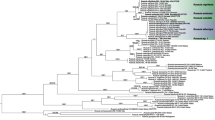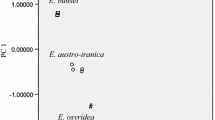Abstract
Although Sikkim belongs to one of the Global Biodiversity Hotspots, little is known about its ectomycorrhizal fungi, and even less about the main genera of Russulales, i.e. Lactarius, Lactifluus, Multifurca and Russula. Combining a multilocus genealogical and morphological study, we aimed to document the diversity within Lactifluus volemus sensu lato of Sikkim Himalaya. We compared nuclear ITS and LSU rDNA, nuclear rpb1 and rpb2 protein-coding, and mitochondrial atp6 protein-coding genealogies to determine species boundaries. Interspecific relationships were inferred from the combined dataset. Bayesian and maximum likelihood single-locus genealogies are concordant and support recognition of six species. Three of these could be identified by unique morphological characteristics and are described as new species: L. dissitus, L. leptomerus and L. versiformis.










Similar content being viewed by others
References
Acharya K, Rai M, Pradhan P (2010) Agaricales of Sikkim Himalaya: a review. Researcher 2(5):29–38
Avise JC, Ball RM (1990) Principles of genealogical concordance in species concepts and biological taxonomy. In: Futuyama D, Antonovics J (eds) Evolutionary biology. Oxford University Press, New York, pp 45–67
Barton NH (2011) What role does natural selection play in speciation. Philos Trans R Soc B 365:1825–1840
Baum D, Shaw KL (1995) Genealogical perspectives on the species problem. In: Hoch PC, Stephenson AG (eds) Experimental and molecular approaches to plant biosystematics. Missouri Botanical Garden, St. Louis, pp 289–303
Beiko RG, Keith JM, Harlow TJ, Ragan MA (2006) Searching for convergence in phylogenetic Markov chain Monte Carlo. Syst Biol 55(4):553–565
Berkeley MJ (1852) Decades of fungi, decades XXXIX., XL. Sikkim and Khassya Fungi. In Hooker’s Journal of Botany 4:130–142
Bhupathy S, Chettri B, Bauer AM (2009) Rediscovery and revalidation of Takydromus sikkimensis (Günther, 1888) (Squamata: Lacertidae) from Sikkim, India. J Herpetol 43(2):267–274
Blackwell M (2011) The fungi: 1, 2, 3 … 5.1 million species? Am J Bot 98(3):426–438
Buyck B, Hofstetter V, Eberhardt U, Verbeken A, Kauff F (2008) Walking the thin line between Russula and Lactarius: the dilemma of Russula subsect. Ochricompactae. Fungal Diversity 28:15–40
Buyck B, Hofstetter V, Verbeken A, Walleyn R (2010) Proposal to conserve Lactarius nom. cons. (Basidiomycota) with a conserved type. Taxon 59(1):295–296
Castresana J (2000) Selection of conserved blocks from multiple alignments for their use in phylogenetic analysis. Mol Biol Evol 17:540–552
Chettri N (2010) Cross-taxon congruence in a trekking corridor of Sikkim Himalayas: surrogate analysis for conservation planning. J Nat Conserv 18:75–88
Das K (2010) Russulaceae of Kumaon Himalaya: an overview. In: Mukerji KG, Manoharachary CIK (eds) Taxonomy and ecology of Indian Fungi. International Publishing House Pvt. Ltd, New Delhi, pp 171–186
Das K, Van de Putte K, Buyck B (2010) New or interesting Russula from Sikkim Himalaya (India). Cryptogam Mycol 31(4):373–387
Dentinger BTM, Ammirati JF, Both EE, Desjardin DE, Halling RE, Henkel TW, Moreau P-A, Nagasawa E, Soytong K, Taylor AF, Watling R, Moncalvo J-M, McLaughlin DJ (2010) Molecular phylogenetics of porcini mushrooms (Boletus section Boletus). Mol Phylogenet Evol 57:1276–1292
De Ruiter PC, Neutel A-M, Moore J (2005) The balance between productivity and food web structure in soil ecosystems. In: Bardgett RD, Usher MB, Hopkins DW (eds) Biological diversity and Function in Soils, pp 139–153. Cambridge University Press. British Ecological Society
Dettman JR, Jacobson DJ, Taylor JW (2003) A multilocus genealogical approach to phylogenetic species recognition in the model Eukaryote Neurospora. Evolution 57(12):2703–2720
Drummond AJ, Rambaut A (2007) BEAST: Bayesian evolutionary analysis by sampling trees. BMC Evol Biol 7:214
Fries EM (1821) Systema mycologicum 1:69. Uppsala. Sweden
Frøslev TG, Matheny PB, Hibbett DS (2005) Lower level relationships in the mushroom genus Cortinarius (Basidiomycota, Agaricales): a comparison of RPB1, RPB2, and ITS phylogenies. Mol Phylogenet Evol 37:602–618
Garnica S, Weiss M, Oertel B, Ammirati J, Oberwinkler F (2009) Phylogenetic relationships in Cortinarius, section Calochroi, inferred from nuclear DNA sequences. BMC Evol Biol 9:1
Gazis R, Rehner S, Chaverri P (2011) Species delimitation in fungal endophyte diversity studies and its implications in ecological and biogeographic inferences. Mol Ecol 20:3001–3013
Giachini AJ, Hosaka K, Nouhra E, Spatafora J, Trappe JM (2010) Phylogenetic relationships of the Gomphales based on nuc-25S-rDNA, mit-12S-rDNA, and mit-atp6-DNA combined sequences. Fungal Biol 114(2–3):224–234
Gianinazzi S, Gollotte A, Binet M-N, van Tuinen D, Redecker D, Wipf D (2010) Agroecology: the key role of arbuscular mycorrhizas in ecosystem services. Mycorrhiza 20:519–530
Hall TA (1999) BioEdit: a user-friendly biological sequence alignment editor and analysis program for Windows 95/98/NT. Nucleic Acids Symp 41:95–98
Halling RE, Osmundson TW, Neves M-A (2008) Pacific boletes: implications for biogeographic relationships. Mycol Res 112:437–447
Hesler LR, Smith AH (1979) North American species of Lactarius. Univ. Michigan Press, Ann Arbor
Kardol P, Wardle DA (2010) How understanding aboveground-belowground linkages can assist restoration ecology. Trends Ecol Evol 25(11):670–679
Katoh K, Toh H (2008) Recent developments in the MAFFT multiple sequence alignment program. Brief Bioinform 9(4):286–298
Kauserud H, Stensrud O, Decock C, Shalchian-Tabrizi K, Schumacher T (2006) Multiple gene genealogies and AFLPs suggest cryptic speciation and long-distance dispersal in the basidiomycete Serpula himantioides (Boletales). Mol Ecol 15(2):421–431
Knowlton N (1993) Sibling species in the sea. Annu Rev Ecol Syst 24:189–216
Kornerup A, Wanscher JH (1978) Methuen handbook of colour, 3rd edn. Methuen, London
Kretzer AM, Bruns TD (1999) Use of atp6 in fungal phylogenetics: an example from the Boletales. Mol Phylogenet Evol 13(3):483–492
Le HT (2007) Biodiversity of the genus Lactarius (Basidiomycota) in northern Thailand. PhD dissertation. Chiang Mai University
Le HT, Nuytinck J, Verbeken A, Lumyong S, Desjardin DE (2007) Lactarius in Northern Thailand: 1. Lactarius subgenus Piperites. Fungal Divers 102:281–291
Leake JR, Johnson D, Donnelly DP, Boddy L, Read DJ (2005) Is diversity of mycorrhizal fungi important for ecosystem functioning? In: Bardgett RD, Usher MB, Hopkins DW (eds) Biological diversity and function in soils, pp 216–235. Cambridge University Press. British Ecological Society
Lemmon AR, Moriarty EC (2004) The importance of proper model assumptions in Bayesian phylogenetics. Syst Biol 53:265–277
Loreau M, Naeem S, Inchausti P, Bengtsson J, Grime JP, Hector A, Hooper DU, Huston MA, Raffaelli D, Schmid B, Tilman D, Wardle DA (2001) Biodiversity and ecosystem functioning: current knowledge and future challenges. Science 294(5543):804–808
Maron JL, Marler M, Klironomos JN, Cleveland CC (2011) Soil fungal pathogens and the relationship between plant diversity and productivity. Ecol Lett 14:36–41
Matheny PB (2005) Improving phylogenetic inference of mushrooms with RPB1 and RPB2 nucleotide sequences (Inocybe; Agaricales). Mol Phylogenet Evol 35:1–20
Matheny PB, Liu YJ, Ammirati JF, Hall BD (2002) Using RPB1 sequences to improve phylogenetic inference among mushrooms (Inocybe, Agaricales). Am J Bot 89(4):688–698
Mittermeier RA, Gil PR, Hoffman M, Pilgrim J, Brooks T, Mittermeier CG, Lamoreaux J, Da-Fonseca GAB (2005) Hotspots revisited. Earth’s biologically richest and most endangered terrestrial ecoregions. Conservation International, Arlington
Montoya L, Bandala VM, Guzmán G (1996) New and interesting species of Lactarius from Mexico including scanning electron microscope observations. Mycotaxon 57:411–424
Nuytinck J, Verbeken A (2005) Morphology and taxonomy of the European species in Lactarius sect. Deliciosi (Russulales). Mycotaxon 92:125–168
Nylander JAA (2004) MrModeltest v2. Program distributed by the author. Evolutionary Biology Centre, Uppsala University
Pringle A, Baker DM, Platt JL, Wares JP, Latgé JP, Taylor JW (2005) Cryptic speciation in the cosmopolitan and clonal human pathogenic fungus Aspergillus fumigatus. Evolution 59(9):1886–1899
Robinson CH, Pryce Miller EJ, Deacon LJ (2005) Biodiversity of saprotrophic fungi in relation to their function: do fungi obey the rules? In: Bardgett RD, Usher MB, Hopkins DW (eds) Biological diversity and function in soils, pp 189–215. Cambridge University Press. British Ecological Society
Robison MM, Chiang B, Horgen PA (2001) A phylogeny of the genus Agaricus based on mitochondrial atp6 sequences. Mycologia 93:30–37
Ronquist F, Huelsenbeck JP (2003) MrBayes 3: Bayesian phylogenetic inference under mixed models. Bioinformatics 19:1572–1574
Shimono Y, Hiroi M, Iwase K, Takamatsu S (2007) Molecular phylogeny of Lactarius volemus and its allies inferred from the nucleotide sequences of nuclear large subunit rDNA. Mycoscience 48:152–159
Stamatakis A (2006) RAxML-VI-HPC: maximum likelihood-based phylogenetic analyses with thousands of taxa and mixed models. Bioinformatics 22:2688–2690
Stubbe D, Nuytinck J, Verbeken A (2010) Critical assessment of the Lactarius gerardii species complex (Russulales). Fungal Biol 114:271–283
Taylor JW, Jacobson DJ, Kroken S, Kasuga T, Geiser DM, Hibbett DS, Fisher MC (2000) Phylogenetic species recognition and species concepts in fungi. Fungal Genet Biol 31:31–32
Van de Putte K, Nuytinck J, Stubbe D, Le HT, Verbeken A (2010) Lactarius volemus sensu lato (Russulales) from northern Thailand: morphological and phylogenetic species concepts explored. Fungal Divers 45:99–130
van der Heijden MGA, Horton TR (2009) Socialism in soil? The importance of mycorrhizal fungal networks for facilitation in natural ecosystems. J Ecol 97:1139–1150
Vellinga EC (1988) Glossary. In: Bas C, Kuyper TW, Noordeloos ME, Vellinga EC (eds) Flora Agaricina Neerlandica vol 1. AA Balkema, Rotterdam, pp 54–64
Verbeken A (1998) Studies in tropical African Lactarius species. 5. A synopsis of the subgenus Lactifluus (Burl.) Hesler and A.H. Sm. Emend. Mycotaxon 66:363–386
Verbruggen H, De Clerck O, Kooistra W, Coppejans E (2005) Molecular and morphometric data pinpoint species boundaries in Halimeda section Rhipsalis (Bryopsidales, Chlorophyta). J Phycol 41:606–621
Wang XH (2007) Type studies of Lactarius species published from China. Mycologia 99(2):253–268
Xia X, Xie Z (2001) DAMBE: data analysis in molecular biology and evolution. J Hered 92:371–373
Yang Z, Rannala B (2010) Bayesian species delimitation using multilocus sequence data. PNAS 107(20):9264–9269
Zamin TJ, Baillie JEM, Miller RM, Rodriguez JP, Ardid A, Collen B (2010) National red listing beyond the 2010 target. Conserv Biol 24(4):1012–1020
Acknowledgments
The first author is supported by the “Bijzonder Onderzoeksfonds Ghent University” (BOF). The survey in Sikkim Himalaya was financially supported by the Research Foundation Flanders (FWO). We would like to express our gratitude to all who helped during the fieldwork: Sundar K. Rai, Pema Bhutia and his family. Help rendered by the Forest Department of Sikkim is also duly acknowledged. We would like to thank Heroen Verbruggen for providing the script for calculating MrBayes burn-in values and convergence times and the comments on the MrBayes analyses. Kenneth Bauters, Heroen Verbruggen and the UGent Helpdesk DICT are thanked for their help with the use of the High Performance Computer. The National Botanical Garden of Belgium is thanked for the use of the scanning electron microscope and in particular Myriam de Haan for taking the photographs. We also wish to thank two anonymous reviewers for their comments on the manuscript.
Author information
Authors and Affiliations
Corresponding author
Electronic supplementary material
Below is the link to the electronic supplementary material.
ESM 1
(PDF 2568 kb)
Rights and permissions
About this article
Cite this article
Van de Putte, K., Nuytinck, J., Das, K. et al. Exposing hidden diversity by concordant genealogies and morphology—a study of the Lactifluus volemus (Russulales) species complex in Sikkim Himalaya (India). Fungal Diversity 55, 171–194 (2012). https://doi.org/10.1007/s13225-012-0162-0
Received:
Accepted:
Published:
Issue Date:
DOI: https://doi.org/10.1007/s13225-012-0162-0




